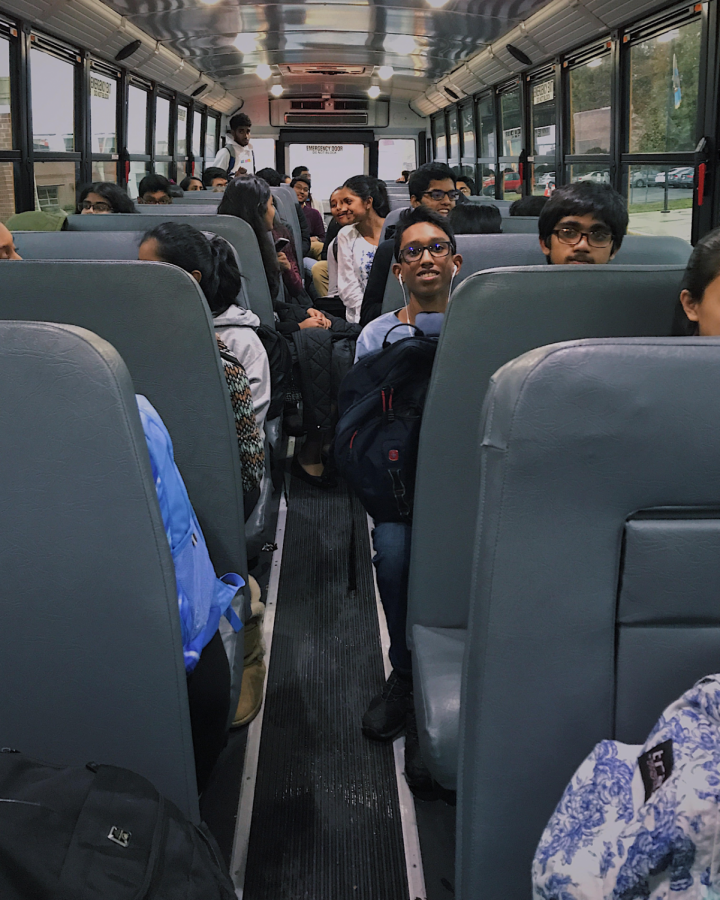All stacked up
The social hierarchy present among classes can be seen in the layout of where people sit on the bus
Walking onto bus 970, the hierarchical sectioning becomes apparent with freshman in the front, seniors in the back, and sophomores and junior filling up the middle
November 9, 2018
Five rows down, I count as I walk down the aisle to my rightful place on the bus. I scan over the segregated classes in their respectful sections, representing the ever apparent social hierarchy. As usual, the freshmen are in the front, followed by the sophomores, juniors, and finally, seniors, the kings of the school. As I see this, the questions start to stand out to me: what do we find so compelling about sitting in the back of the bus? Does it make us feel as if we have finally made it to the top? In other words, what is so different about the back of the bus that has caused an ongoing tradition of seniors sitting in the back?
“I definitely see this social hierarchy on the bus. In fact, I don’t think I’ve ever been on a school bus where a hierarchy hasn’t been the norm,” said junior Medha Gupta when asked whether she has seen this social hierarchy on the bus herself.
However, in some buses the layout is the reverse, with freshmen in the back and seniors in the front.
“[On my bus] generally the juniors are in the front, the freshmen are in the middle, and the sophomores are in the back,” said sophomore Jing Liu.
The reason for this is mainly because the underclassmen tend to arrive first on the bus. Nonetheless, there has always been some type of separation among the different grade levels on the bus, and this concept is pertinent in understanding the social hierarchy. The overarching idea of why there is segregation between the classes lies in the reasoning that people of the same age group tend to be in the same classes and are thus friends. Therefore, people in the same grade tend to sit near each other and ‘section’ together. The prominent reason for why this grouping is maintained is that people want to know where to sit based on where they think their friends will sit.
“I think it helps us know where to sit at times because whenever I would get onto the bus and I wouldn’t know where to sit, I could approximate where my friends would be sitting,” said Gupta.
In addition to this, many students (especially upperclassmen) like to sleep or study on the bus, thereby valuing their personal space. Due to this, upperclassmen typically get frustrated when underclassmen do not abide by their designated sections. This division works to provide space by granting certain areas of the bus to certain classes so there is no conflict between the grade levels.
It is then important to understand why seniors choose to sit in the back. The main reason why this tradition of seniors sitting in the back arose is because while sitting in the back, students feel that they can be louder and that they have more freedom.
“I think that generally the back of the bus is more talkative than the front. There’s just more going on,” said freshman Benjamin Change.
Students prefer to sit in the back to be part of this lively environment. Furthermore, students may choose to sit in the back as the reputation of being “cool” is associated with sitting in the back of the bus.
“I definitely do think that there’s the idea that sitting in the back makes you “cooler” or “better” than all of the other people, ” said Gupta.
The above is why seniors started to sit in the back of the bus. After four years of consistent hard work, they felt as if they deserved the lively environment and freedom.
“As seniors, we have endured the longest through TJ so we have at least earned some comfort on the bus. Every class will get their turn; they just have to wait for it. It’s just like life. You cannot expect when you get hired for a job to be at the top from day one. You have to earn it,” said senior Raghav Khator.
The initial action of seniors sitting in the back sparked an ongoing tradition, which continues because we now connect the back of the bus with being a senior. Due to the mindset of current and assumably past seniors, we now always associate the back of the bus to having made it to the top, which is supported by Khator’s statement. By wanting to feel like the top of the school, we are naturally drawn towards the back. It is not only students tendencies to aggregate with people in their class, but also the environment of the back of the bus and the long-lasting tradition of seniors. In the end, it all stacks up, pushing us to believe that once we have made it to the back of the bus, we truly are the kings.






